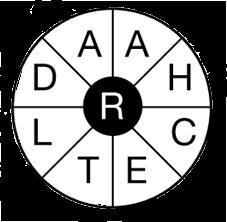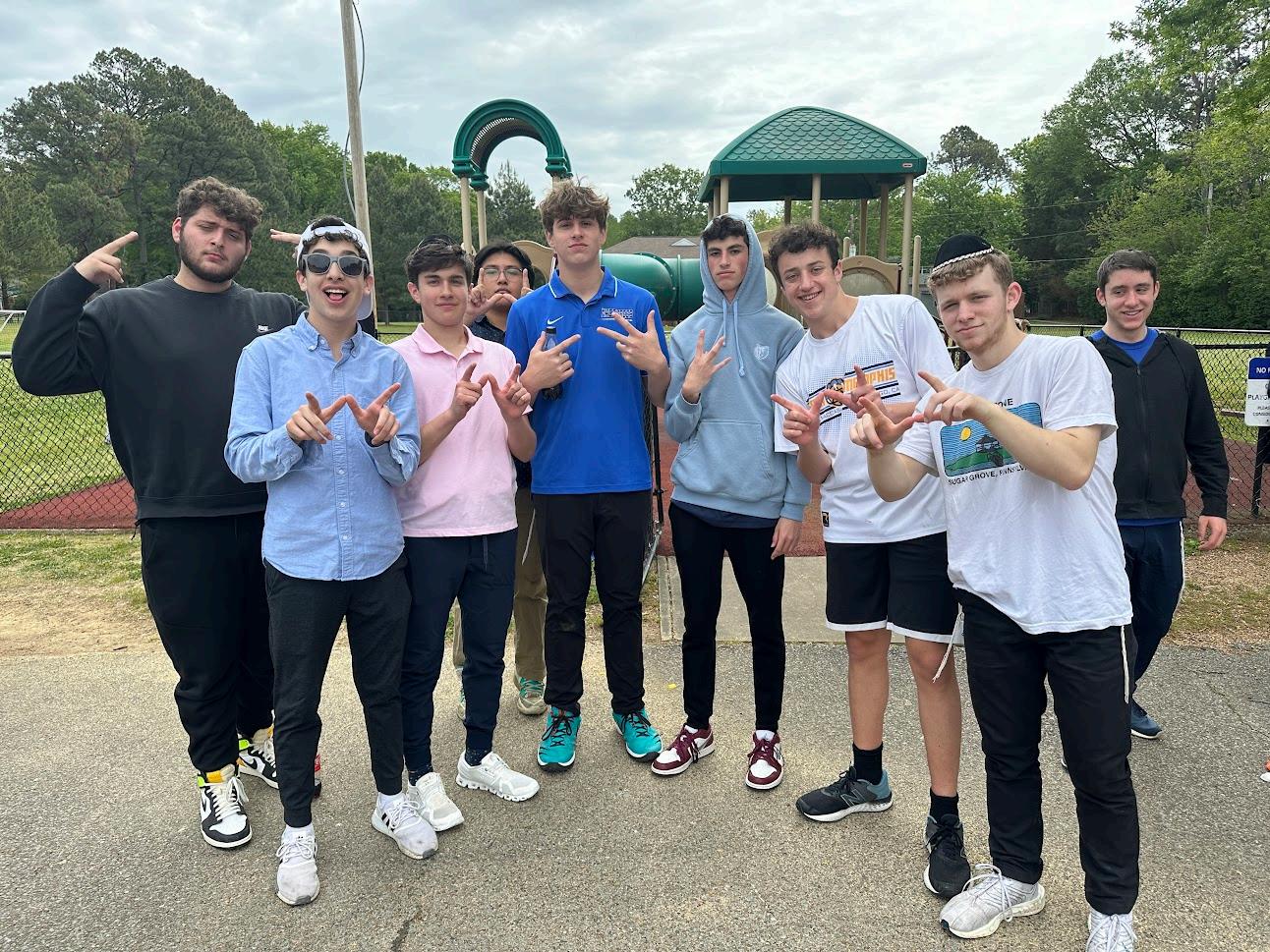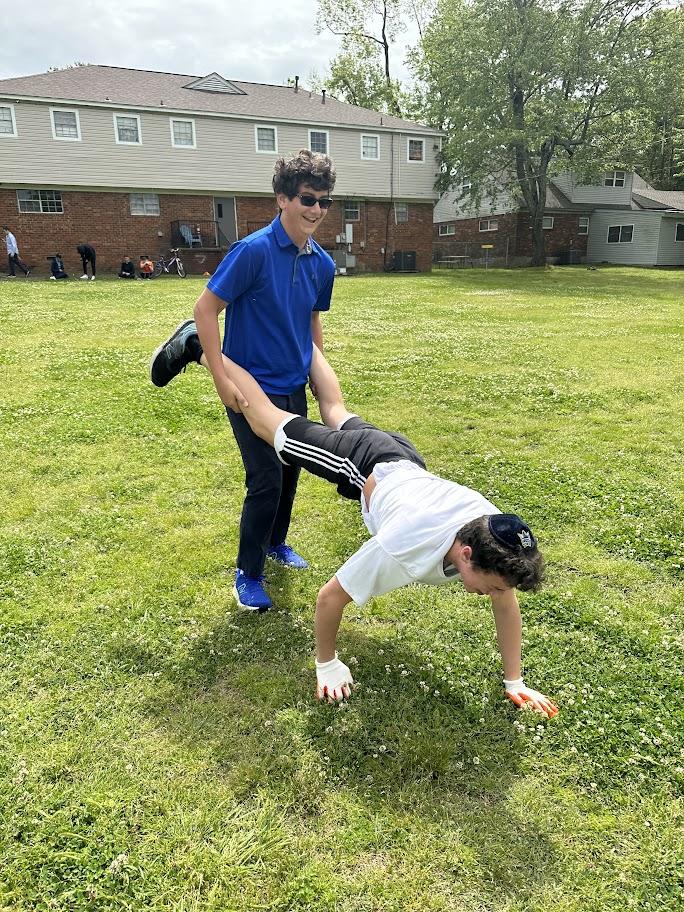CYHSB WEEKLY
Cooper Yeshiva
High School for Boys
Volume 17, Issue 15
Weekly Puzzle: Word
Wheel Page 3
Melancholy to Exuberance: Yom
Hazikaron and Yom
Haatzmaut
Page 4
Huge Leaps in Computer Generation
Page 5
Cooper Clicks
Page 6
Parshas Acharei Mos-
Kedoshim: Finding a
Balance
Page 7
This week’s Weekly is in honor of Shayna Rachel bat
Eliyahu Z”L
Is the Weekly Killing Trends? A Deep Dive Into the Weekly Efect

Rafi Davidovics (26’)
A strange phenomenon has been happening in the CYHSB for quite some time now, but I have personally not seen anyone talking about it. Movements that appear strong enough to withstand the test of time are stifled out overnight, and trends with tons of enthusiasm become boring for us CYHSBers in what seems an unnatural amount of time. These strange occurrences made me start to think, and what I uncovered might just shock you. As I was searching for a common theme between all of these events I realized that every time a movement had died in the CYHSB it was always and I
mean always right after a Weekly article was made on it. This strange phenomenon is something I like to call the “Weekly Effect.” Many movements have fallen prey to the Weekly Effect; however, if we wish to truly understand what is going on here we must go back to the first recorded Weekly Effect occurrence.
2022 was a pretty wild time, and a lot of us have some pretty wild memories, but it’s hard to forget one of the most iconic parts of 2022, Wordle. Wordle was a highly addictive word game that achieved massive success worldwide as well in the CYHSB. Many students got very into

Volume 17, Issue 15 April 28th, 2023 CYHSB Weekly 1
The Weekly Effect is observed to cause a drop in CYHSB interest in the things which the Weekly reports on. Source: Nadav Lowell
Wordle and started WhatsApp groups with friends where they would share their scores and brag about how fast they solved the puzzle. However, one day it all just stopped. The week after an article was published in the Weekly about the Wordle craze, everyone stopped playing. Students were really shocked by this, as Senior Reuven Marvin said: “Wordle was huge in the CYHSB and every day at breakfast everyone would be competing for who can get the best score. So, of course I was shocked when it died off shortly after the article was written.” As you can clearly see, this abrupt end to a trend that was very strong came as a surprise to many students in the CYHSB. However, this was not the last case of the ominous Weekly Effect.
One recent case of the Weekly Effect is Chess.com. Chess recently took over the CYHSB by storm, and tons of people were playing every day at every break they had. It seemed like an unstoppable force, with many students obsessing over it for the sole reason of becoming the best chess player in the CYHSB. However, what was once a thriving movement became a once-in-awhile thing with usually a max of one or two people playing at a time. Freshman Amit Zalman had this to say on this particular Weekly Effect: “I was shocked when the chess trend went away in the CYHSB, it seemed like it would last for much longer. However, these days we would be lucky if we got to have one game every other day.” In Ezra Wiener’s article on the rise of chess in the CYHSB, he wrote, “Chess is a great game that allows you to think and develop strategic skills, it also is a fun way to challenge yourself. Hopefully, its popularity in school will only continue to
grow.” This begs the question: with overwhelming support from the student body seen in Amit’s quote, as well as an article that seems to only motivate the movement and encourage it to thrive, how could this trend die off? Why is the Weekly Effect occurring? Before answering that question, I would like to look at one case that seemed slightly different. This trend is a very recent one: the game Wordscapes. Wordscapes, similar to Wordle, is a highly addictive word game where you have to solve word puzzles. However, there is one key difference: unlike Wordle, where you can only play one puzzle a day, in Wordscapes you can play an infinite amount of puzzles. Due to the game’s ability to play as much as you want, and the increased addictiveness, the whole school started playing Wordscapes at a much faster rate than any of the other trends. However, what really stood out to me was the drastic difference between the Weekly article covering Wordscapes and the ones that covered all the other trends. This Weekly article seemed negative, where all the others seemed positive. For example, in the Wordscapes article written by Ezra Wiener it says: “While this game might be popular, it is already showing early signs of dwindling popularity.” So, why is this case different from all the other cases? Why did a trend that was so addictive and can so quickly die so fast? And, to restate our most pressing question: Why does the Weekly Effect occur?
To answer these questions, we have to take a closer look at how the Weekly is made. Every two weeks on Monday we have our Weekly meetings, where we decide what topics we will be writing

about for the next two weeks. Because of this, if something happens the Tuesday after a meeting it will not be written about for two weeks. The trends written about in the Weekly are most likely already old by the time they are written about, and this is most likely the case for most trends because of the way these trends start. The majority of trends are started by just one student over the weekend, and if it is good enough the student might bring it to school and share it with friends. They will start that process on Monday when we have our meeting, and by the time it has become a major trend it is already Tuesday or later and thus it cannot be in the Weekly for at least two weeks.
While this is a good explanation, it still does not fully explain why the trends die off so fast. To answer this question I began researching and what I found is very interesting. I found a fascinating study on popular baby names that showed that baby names that were adopted faster also went away faster. It says in the study on phys.org: “According to the results, the quicker a cultural item rockets to popularity, the quicker it dies.” This would explain why Wordscapes went away faster than all the other trends; it also caught on faster than all the other trends. Another source from proceedings of the National Academy of Sciences says, “cultural tastes that have been adopted quickly die faster.”
With all this in mind you can see why the Weekly Effect takes place. Trends don’t make it in time to the Weekly meetings; because of how fast they catch on in a small school, by the time they do make it to the Weekly the trend has already died off and the CYHSB has moved on to other things. If you want to be more fun, however, you can just believe that the CYHSB Weekly has magical powers.

Volume 17, Issue 15 April 28, 2023 CYHSB Weekly 2
The weekly which proved the effect. Photo: Ethan Vanderwalde
Word Wheel



Volume 17, Issue 15 April 28, 2023 CYHSB Weekly 3
person to send in a completed puzzle to nathan.greenbaum@mhafyos.org gets a prize!
First
- Printed with express permission fom Bil Watterson
Melancholy to Exuberance: Yom Hazikaron and Yom Haatzmaut
Amit Zalman (’26)
Yom Hazikaron and Yom Haatzmaut are two important national holidays for Israel and the Jewish people. These holidays hold a deep significance for Israelis and serve as a reminder of the country’s history and the sacrifices made to defend it. Yom Hazikaron, also known as Israel’s Memorial Day, is a day to remember and honor the soldiers who have fallen in defense of the country, as well as the victims of terrorism.
The remembrance in Israel begins with a siren at 8:00 in the evening, and Israeli citizens stop whatever they’re doing to stand and listen for their remembrance. Private memorial ceremonies take place the following day, with another two-minute siren at 11:00 in the morning. This day of remembrance is a time for families and communities to come together to mourn and remember those who have passed away. Many Israelis visit the graves of their loved ones or attend memorial services. In addition, schools and community centers hold events to commemorate the fallen and honor their sacrifices. The day really highlights the importance of remembering the sacrifice and bravery of those who gave their lives in order to defend our Independence and protect Israel.
Last Week’s Solution

At the MHA, the Kollel Torah Mitzion and Bat Ami organized a Yom Hazikaron ceremony that the school attended. They taught us about 8 important soldiers that sacrificed their life in honor of Israel and we stood up for sirens that marked a moment of silence. We ended off the ceremony with a meaningful Hatikva.
On the other hand, Yom Haatzmaut, or Israeli independence

day, is a celebration of the country’s founding and its continued existence as a Jewish state. It’s a day to celebrate freedom and the strength of the Israeli people. This year, Margolin Hebrew Academy participated in its annual march to celebrate Yom Haatzmaut. The whole school joins together to parade through the streets of the school and neighborhood. The march is a way for our students to connect with the broader Jewish community and deliver our support for Israel.
For me, as an Israeli, Yom Haatzmaut holds a special place in my heart. It’s a day to celebrate our independence and the freedom that we have fought so hard for throughout the years. It’s a time to come together as a community and show our pride in our country. When marching, with friends, family, and teachers, I feel a sense of unity and pride as I see all the students come together to celebrate
this special day. The march at Margolin Hebrew Academy really is an important part of our celebration of Yom Haatzmaut.
As we celebrate Yom Haatzmaut and participate in the march at Margolin Hebrew Academy, it also gives us a moment to remember and honor the fallen soldiers and victims of terrorism.
Ultimately, it’s important to note that both Yom Hazikaron and Yom Haatzmaut are not just about the past, but also about the future. As Israel continues to face challenges and threats, it’s important to come together as a community to support and defend the state of Israel with every given chance. These holidays serve as a reminder of the sacrifices that have been made and the ongoing responsibility that we all have to ensure the safety of the State of Israel.
Volume 17, Issue 15 April 28, 2023 CYHSB Weekly 4
Yom Hazikaron and Yom Haatzmaut were observed this past week. source: depositphotos.com
Huge Leaps in Computer Generation
Jonathan Ardestani (’25)
In the world of technology, new inventions and discoveries happen every day.
One recent piece of technology that has taken the world by storm is the MetaHuman Creator. This new software developed by Epic Games allows anyone to create realistic digital humans for use in movies, video games, and virtual reality simulations. MetaHuman Creator was released in early 2021 and has since gained immense popularity among video game developers and movie producers. With this software, creators can generate a wide range of human characters that look and behave like real people. The characters can be customized to include various facial features, body types, and clothing styles.
made body and facial templates that can be customized with a range of parameters. Users can adjust things like skin color, hair style, and even the character's teeth. The software also includes a range of animations that can be applied to the character to give them natural
their upcoming games, while movie producers are using it to create realistic digital doubles of actors for use in special effects sequences. The software has also been used to create digital humans for use in training simulations for the military and other industries.
Last Week’s Solution
One of the most remarkable features of the MetaHuman Creator is the level of detail that it can produce. With advanced algorithms and artificial intelligence, the software can simulate facial expressions and movements in a way that is eerily lifelike. This level of realism is a significant improvement over previous digital character creation tools and has opened up new possibilities for filmmakers and game developers.

Creating a character with the MetaHuman Creator is a relatively straightforward process. The software includes a library of pre-
movements and expressions.
One of the most exciting aspects of the MetaHuman Creator is its potential for use in virtual reality simulations. With the rise of virtual reality technology, creating realistic human avatars has become a critical part of the experience. The MetaHuman Creator can help developers create avatars that look and behave like real people, enhancing the immersive nature of virtual reality simulations.
The impact of the MetaHuman Creator has been felt across the gaming and movie industries. Game developers are using the software to create characters for
While the MetaHuman Creator has been widely praised for its realism and ease of use, some have raised concerns about the potential misuse of the technology. The software could be used to create deep fake videos and other types of digital manipulation that could be used to deceive or harm others. As with any new technology, it is essential to consider the potential risks and benefits carefully. In conclusion, the MetaHuman Creator is a revolutionary new piece of technology that has the potential to transform the way we create digital humans for movies, video games, and virtual reality simulations. With its advanced algorithms and lifelike realism, it has already become a favorite among game developers and movie producers. While there are some concerns about its potential misuse, the benefits of the technology are significant. As the technology continues to evolve, it will be exciting to see what new possibilities it will unlock for creators in the future.
Volume 17, Issue 15 April 28, 2023 CYHSB Weekly 5
Make sure to check out and follow our brand new CYHSB account @cooperyeshiva on instagram!
MetaHuman Creator alows you to create realistic digital
Cooper Clicks

Images: Top lef: Raanan and Ethan’s rivalry goes too far as Raanan attempts to fling Ethan into the sun.Top middle: Due to his massive amount of Zionism, Ezra Wiener grows three feet In height every Yom Haatzmaut. Right: The worst team in the field day games holds up double L’s to signify their loss. Bottom right: Four members of the CYHSB violate the issur of wearing four cornered garments without Tzitzis. Bottom lef: CYHSBers watch as Benny Frieden attempts to float on his back







Volume 17, Issue 15 April 28, 2023 CYHSB Weekly 6
Parshas Acharei Mos-Kedoshim: Finding a Balance
Avi Becker (’24)
Life is all about finding a balance. It is about finding that middle ground between the two extremes that lie on either end of every decision that you ever make in your entire life, no matter the situation, no matter the circumstance.

The Rambam writes in Hilchos Dayos that there are many different types of people in the world, each with their own characteristics and opinions. There are people who are quick to lose their temper and get unnecessarily angry, but there are also those who are very calm and lose their temper infrequently. One person is very haughty, another is very humble. One person has an insatiable appetite for all kinds of physical pleasures, while another has minimal physical needs. One person is exceedingly generous, another other is very stingy. With all these middos (personality traits), there are people all along the spectrum, from one extreme to the other.
Last Week’s Solution
The Rambam writes that in each instance, both extremes are not desirable. To be an extremist in any middah is not appropriate. The proper way, the Rambam writes, is the “Golden Mean” – the middle road. Each personality trait has a point equidistant between the two
extremes that is most fitting and appropriate for proper behavior, and can apply in each and every situation.
The Rambam says that this approach of the “Golden Mean” is called “Derech Hashem” by the Torah. This is what Avraham taught


Where did the Rambam see this principle in this pasuk? Normally, whenever the Rambam cites a proof from a text, it is precise. The implication is usually clearly spelled out in the scriptural pesukim he quotes. Here, we are puzzled: how does this pasuk indicate that a person should conduct himself according to the “Golden Mean?”

his descendants.
Where do we see that Avraham Avinu taught his children that they should always take this “middle approach?” The Rambam cites the pasuk (verse) in our parsha, “For I have cherished him because he commands his children and his household after him that they keep the way of Hashem (Derech Hashem), doing charity and justice, in order that Hashem might bring upon Avraham that which He had spoken of him.” [Bereishis 18:19]
The answer is that when the Rambam says that we need to approach life going down the middle path, he does not mean that a person always needs to take the middle approach. The Rambam means that a person’s attitude is equidistant from the two extremes, and that when the time comes, the person can employ one extreme or the other, as appropriate for the circumstances. It does not mean that we always take the middle road.
In this week’s double parsha we see a dichotomy between both parts. In the first we see Nadav and Avihu die for being “too” spiritual and suddenly, in the next parsha, we see the guide to becoming the most prized level of spirituality and reaching those divine heights. In order to understand this dichotomy it is best to understand that one must walk in the middle of the road.
Volume 17, Issue 15 April 28, 2023 CYHSB Weekly 7
AP tests are starting next Week! APES - May 2 AP Lit - May 3 AP Art History - May 5 AP Calculus - May 9
It is important in life to not be in any extremes, but rather walk the middle road.. Source:
Sponsor an Issue
A sponsorship is a great way to honor the memory of a loved one, celebrate an accomplishment, or just show appreciation to the CYHSB Weekly. We reach hundreds of people each week, helping to get your announcement out for just $20.
CYHSB Weekly Staff
Editor-in-Chief
Ezra Davidovics | ezra.davidovics@mhafyos.org
Associate Editor-in-Chief
Nadav Lowell | nadav.lowell@mhafyos.org
Layout Editor

Nathan Greenbaum | Nathan.greenbaum@mhafyos.org
Assistant Layout Editor
Amit Zalman | amit.zalman@mhafyos.org
Managing Editors
Ethan VanderWalde | ethan.vanderwalde@mhafyos.org
Raanan Vanderwalde | raanan.vanderwalde@mhafyos.org
News Editors
Joshua Parcover | joshua.parcover@mhafyos.org
Yaron Weiss | yaron.weiss@mhafyos.org
Akiva Levine | akiva.levine@mhafyos.org
Complaint Manager
J.J. Stein | jacob.stein@mhafyos.org
CYHSB Weekly Staff
Avi Becker | avi.becker@mhafyos.org
Baruch Finkleman | baruch.finkleman@mhafyos.org
Rafi Davidovics | rafael.davidovics@mhafyos.org
Benny Freiden | benjamin.freiden@mhafyos.org
Rafi Goldkin | rafael.goldkin@mhafyos.org

Jojo Ardestani | jonathan.ardestani@mhafyos.org
Yosef Vanderwalde | yosef.vanderwalde@mhafyos.org
From the Editor:
As we can see from the discovery of the Weekly Effect pushing something too hard can sometimes push it to obscurity. This may be due to the same detail described in this week’s parshios where the importance of a balance is stressed. The holidays of this week also shared this sentiment showing the extremes of both sides and telling somewhere in the middle. This balance is important in all areas of our lives as we cannot live at either extremes of a situation.
Administrative Advisors
Rabbi Dov Rossman
Mrs. Ashley Brown
- Ezra Davidovics
Volume 17, Issue 15 April 28, 2023 CYHSB Weekly 8

























